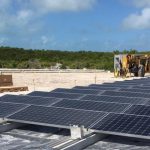
Raglan Solar Project
This project, commissioned by TUGLIQ in 2021, will test bifacial solar photovoltaic panels in an Arctic environment. The project will demonstrate the potential of bifacial panels to reduce greenhouse gas (GHG) emissions associated with the production of energy by diesel generators for off-grid sites in the North. To this end, TUGLIQ designed, built and operated a 40 kWp demonstration solar farm at Raglan Mine. The performance of bifacial solar panels is being tested. Conventional solar panels are also being installed to establish a reference energy production capacity against which the performance of the bifacial panels will be compared.
Project
The solar farm, with a rated output of 40 kWp, comprises 108 photovoltaic panels, spread over a total of 6 tables, of which:
- 72 are monofacial panels (also known as “classic” panels)
- 36 are bifacial panels
It will generate around 40MWh per year of additional renewable energy on the mine’s isolated grid, where two Tugliq wind turbines already operate
Key Facts and Result
- The project demonstrates the technical feasibility of a solar farm in the Canadian Arctic
- The project demonstrates a better performance of bifacial panels over conventional panels in this environment (around 18% on average).
- The park boasts a utilization factor of 12%
Client
Glencore – Raglan Mine
Commissioning Date
2021
SOlar farm capacity
40 kWp
Location
Raglan Mine, Nunavik




